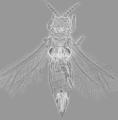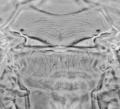Pseudodendrothrips mori
Recognition data
Distinguishing features
Both sexes fully winged; body white, with grey area medially on anterior margin of head, and paired grey areas on pronotum; antennal segments grey, II darkest; fore wings light brown along costa and near base. Antennae variable, 8- or 9-segmented, terminal segments slender; III–IV short with forked sensorium; VI with long sensorium arising on inner margin close to base. Head wider than long, with curving lines of sculpture between ocelli; three pairs of ocellar setae present, pairs I & II lateral to first ocellus, pair III within triangle between anterior margins of hind ocelli; postocular setae not developed. Pronotum with closely spaced transverse striae; one pair of posteroangular setae, three pairs of posteromarginal setae. Metanotum with closely spaced longitudinal lines of sculpture medially, reticulate laterally; campaniform sensilla not developed; median setae small and arising behind anterior margin. Mesofurca with weak spinula, metafurca elongate lyre-shaped. Hind leg with tarsus exceptionally long, more than half as long as tibia. Fore wing first vein with three widely spaced setae on distal half, second vein without setae. Tergites II–VIII with pair of long setae close together medially, laterally with transverse lines of sculpture bearing distinctive linear markings; V–VII medially with up to 10 microtrichia on posterior margin; VIII with complete marginal comb of slender microtrichia. Sternites without discal setae; median setae on VII arise at margin.
Male similar to female but smaller; tergite IX with 4 pairs setae in transverse row; sternites without pore plates.
Related and similar species
There are 19 species currently placed in the genus Pseudodendrothrips, although the identity remains unclear of some of the pale species that are similar to P. mori (Mound, 1999; Mound & Tree, 2007).
Taxonomic data
Current valid name
Pseudodendrothrips mori (Niwa)
Original name and synonyms
- Belothrips mori Niwa, 1908: 180
- Graphidothrips stuardoi Moulton, 1930: 273
Family placement
Thripidae, Dendrothripinae
Biological data
Life history
Feeding and breeding on leaves.
Host plants
Morus spp. (Moraceae)
Tospoviruses vectored
None
Crop damage
Sometimes causing leaf damage on commercial mulberry trees.
Distribution data
Area of origin
Probably southeast Asia
Distribution
California, Georgia, Maryland, Illinois, Chile, Italy, Japan, China, Korea, Taiwan, Australia.





